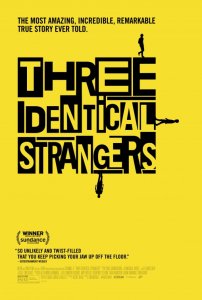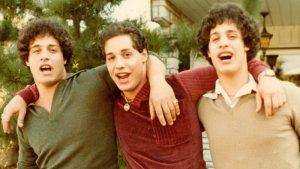The manic joy and deep sadness of Three Identical Strangers reunited as teenagers.
 Director Tim Wardle’s new documentary Three Identical Strangers reminded me slightly of Eugene Jarecki’s standout doc from 2003, Capturing the Friedmans. While Wardle’s film is ultimately not as potentially scarring as Jarecki’s, both stories methodically peel back layers on a unique family situation to add new wrinkles and gradually reveal a darker, fuller picture. Wardle also touches upon the popular debate about what makes a person who they are: is it nature or nurture? The film settles upon one choice early on, but then slowly builds a case for the other one.
Director Tim Wardle’s new documentary Three Identical Strangers reminded me slightly of Eugene Jarecki’s standout doc from 2003, Capturing the Friedmans. While Wardle’s film is ultimately not as potentially scarring as Jarecki’s, both stories methodically peel back layers on a unique family situation to add new wrinkles and gradually reveal a darker, fuller picture. Wardle also touches upon the popular debate about what makes a person who they are: is it nature or nurture? The film settles upon one choice early on, but then slowly builds a case for the other one.
The film starts out, however, like a high concept comedy film from the ’80s. A now fiftysomething Bobby Shafran describes his bizarre first day at college. Arriving on campus, everyone seems to already know who he is. He gets high fives from sports bros and enthusiastic nuzzles from cute girls. Has he stepped into a prank — or paradise?
His college roommate clues him in: he is the spitting image of Eddy Galland, who was big man on campus last year. Eddy didn’t come back to school, so a curious Bobby drives for hours to meet Eddy. He discovers his previously unknown twin brother.
The unlikely coincidence becomes a local news sensation.
The story becomes even more sensational when a man of the same age named David Kellman and his family read the story in the local paper and realize that Bobby and Eddy are doppelgangers of David. Triplets!
 The boys reunite, and their connection is immediate. They talk the same way, they act the same way, they’re interested in the same stuff. The triplets become a media sensation, going on talk shows and schmoozing at high class night clubs. They open their own restaurant named, appropriately, Triplets.
The boys reunite, and their connection is immediate. They talk the same way, they act the same way, they’re interested in the same stuff. The triplets become a media sensation, going on talk shows and schmoozing at high class night clubs. They open their own restaurant named, appropriately, Triplets.
Three Identical Strangers
But that’s not the end of it. The film slowly uncovers the story of how and why these three boys were separated as babies. All three were adopted from the same adoption agency, but none of their new parents were informed about the other boys. When this was discovered, the agency claimed that historically, triplets had an impossible chance of getting adopted together. This explanation turns out to be a cover for the truth. This situation was designed. These boys were selected.
I could explain further, but I won’t. It would undercut some of the film’s power, and it’s just better to hear it from the brothers and their loved ones than to hear it from an internet review.
Three Identical Strangers is a gripping must-see film; by turns moving and infuriating. The brothers’ story acts as a testament to the beauty of human connection and family, but it also suggests the limitations to our understanding of the human mind. If the triplets were test subjects meant to illuminate human development, the final data is inconclusive. Life is more than DNA, and it’s more than the home where you grew up. Bobby, Eddy, and David didn’t start off in the same place and — like most brothers — they don’t end up in the same place either.
Three Identical Strangers opens in New York and LA on June 29. More cities in the weeks to come.

More Pop Culture Beast – Movie Reviews:
*Won’t You Be My Neighbor?, documentary about Fred Rogers
*Summer 1993, with Laia Artigas and Bruna Cusí
*You Were Never Really Here, with Joaquin Phoenix and Ekaterina Samsonov
Justin Remer makes movies, directs music videos, and plays in the bands Duck the Piano Wire and Elastic No-No Band when he is not writing movie reviews. His folk-rock documentary MAKING LOVERS & DOLLARS is currently streaming on Amazon.

